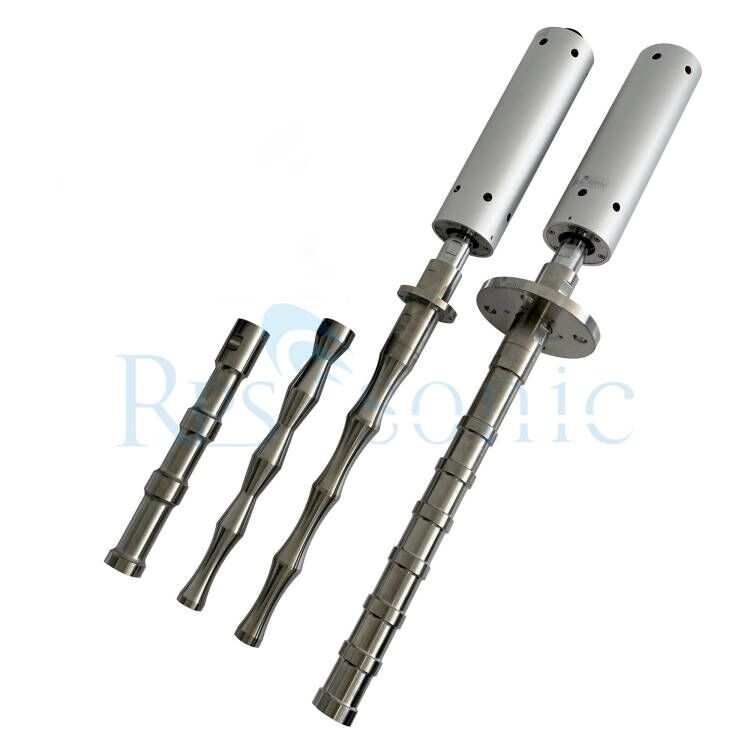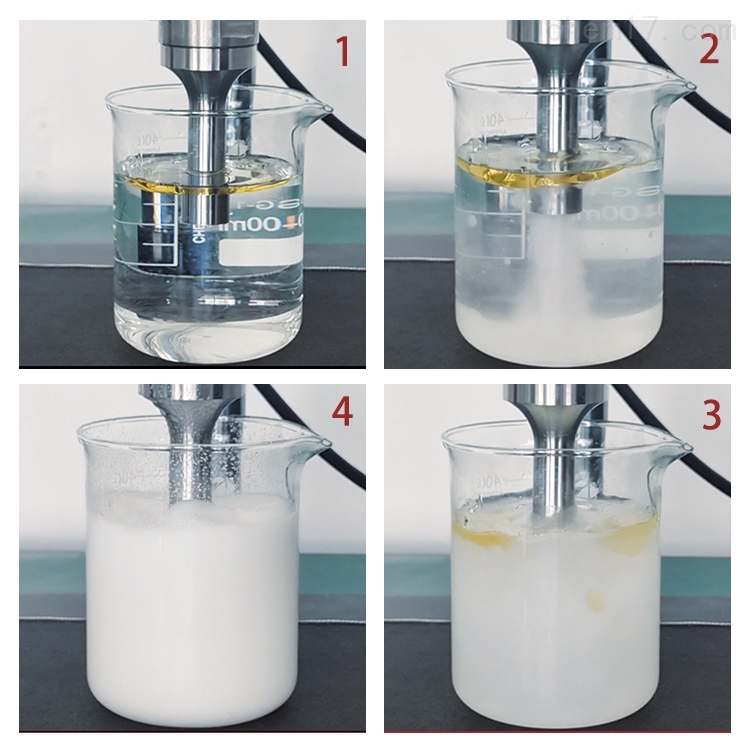Hangzhou Powersonic Equipment Co., Ltd. |
|
Verified Suppliers
|
|
Ultrasonic homogenizer emulsifier in different industrial usage with high amplitude sonotrode
What is ultrasonic emulsifier?
Ultrasonic emulsification refers to the process of mixing two (or
more than two) immiscible liquids evenly to form a dispersion
system under the action of ultrasonic energy, in which one liquid
is evenly distributed in another liquid to form an emulsion.
principle:
The physical mechanism for crushing insoluble solids (or liquids)
is believed to be ultrasonic cavitation. Ultrasonic cavitation
effect means that under the action of strong ultrasonic waves, a
large number of bubbles will be generated in the liquid. The small
bubbles will gradually grow and increase with the ultrasonic
vibration, and then suddenly burst and split. The split bubbles
will continue to grow and burst. . When these small bubbles
collapse rapidly, high temperature and high pressure are generated
in the bubble, and because the liquid around the bubble rushes into
the bubble at high speed, a strong local shock wave is generated in
the liquid near the bubble, which also forms local high temperature
and high pressure, thus producing Ultrasonic crushing and
emulsification.

What is the application of a emulsifer in Industrial use?
In the pharmaceutical industry and daily necessities industry
sector, phacoemulsification is often used to manufacture various
emulsion products, such as emulsion drugs, cosmetics, and leather
shoe polish. Ultrasonic emulsification method can also be used to
produce emulsified combustion products of oil (gasoline, diesel,
etc.) and water or pulverized coal to improve the combustion value
of unit fuel.
This technology has now been promoted and used within a limited
scope, and the economic benefits are obvious. In order to reduce
costs and adapt to larger-scale production, mechanical ultrasonic
transducers such as reed whistles are mostly used in
phacoemulsification. For liquids that are difficult to emulsify or
for other special considerations, piezoelectric ultrasonic
transducers are sometimes used together with an appropriate sound
focusing system to increase the sound intensity.
Phacoemulsification has been used in many fields and plays its
unique role in each field.
There are many industrialized applications of phacoemulsification,
and phacoemulsification is one of the earliest technologies for
ultrasound to be used in food processing. For example, soft drinks,
ketchup, mayonnaise, jam, artificial milk, baby food, chocolate,
salad oil, oily sugar water and other mixed foods used in the food
industry have been tested and adopted at home and abroad, and have
achieved improvements. The effect of product quality and production
efficiency, and aqueous carotene emulsification has been
successfully tested and used in production.
The banana peel powder was pre-treated using physical modification
method of ultrasonic dispersion combined with high-pressure
cooking, and then enzymatically hydrolyzed by amylase. A single
factor experiment was used to study the effect of this pretreatment
method on the extraction rate of soluble dietary fiber in banana
peels and the physical and chemical properties of insoluble dietary
fiber in banana peels. The results showed that ultrasonic
dispersion combined with high-pressure cooking is better than
simple treatment without pretreatment. The insoluble dietary fiber
obtained by enzyme treatment has an increase in water holding
capacity of 5.05g/g, water binding capacity of 4.66g/g, oil holding
capacity of 4.60g/g, and swelling property of 0.4mL/g.

Parameter:
| Item | sono-20-1000 | sono-20-2000 | sono-20-3000 | sono-15-3000 |
| Frequency | 20khz±0.5 | 20khz±0.5 | 20khz±0.5 | 15khz±0.5 |
| Power | 1000w | 2000w | 3000w | 3000w |
| Voltage | 110 or 220V | |||
| Max temp | 300℃ | |||
| Max pressure | 35Mpa | |||
| Itensity of sound | 20W/cm² | 40W/cm² | 60W/cm² | 60W/cm² |
| Capacity | 10L/min | 15L/min | 20L/min | 20L/min |
| Material of probe | Titanium | |||
what is the best emulsifier?
The average droplet size of the emulsion formed by ultrasonic
emulsification is small, which can be 0.2 to 2um; the droplet size
distribution range is narrow, which can be 01 to 10um or
narrower.
The concentration of ultrasonic emulsion is high. The concentration
of pure emulsion can exceed 30%, and the concentration of
emulsifier can be as high as 70%.
The formed emulsion is more stable. An important feature of
ultrasonic emulsification is that no or less emulsifiers can be
used to produce an extremely stable emulsion.
You can control the type of lotion. Using ultrasonic
emulsification, under certain sound field conditions, both O/W
(oil-in-water) and W/O (water-in-oil) emulsions can be prepared;
however, this is not possible with mechanical emulsification
methods, only the properties of the emulsifier You can control the
type of lotion.
Toluene emulsifies in water, forming one type of emulsion under low
sound intensity conditions and another type of emulsion under high
sound intensity conditions.
Ultrasonic emulsification requires little power to produce milk
residue.

how is the ultrasonic make efficient emulsification?
Ultrasonic emulsification achieves efficient emulsification through a phenomenon called cavitation. Cavitation refers to the formation, growth, and violent collapse of microscopic bubbles within a liquid.
When an ultrasonic emulsifier is operated, it emits high-frequency sound waves into the liquid medium. These sound waves create alternating high-pressure and low-pressure cycles in the liquid, leading to the formation of tiny bubbles through a process called nucleation. These bubbles are typically on the order of micrometers in size.
During the low-pressure cycle of the sound wave, the bubbles expand due to reduced pressure. As the pressure increases during the high-pressure cycle, the bubbles rapidly collapse. This collapse of the bubbles is known as implosion or cavitation.
The collapse of these bubbles generates localized hotspots with extremely high temperatures and pressures. The temperature inside the collapsing bubbles can reach thousands of degrees Celsius, while the pressure can exceed 1,000 atmospheres. This phenomenon is called transient cavitation.
The violent collapse of the bubbles during cavitation produces intense shear forces, shockwaves, and microjets within the liquid. These forces cause the disruption and breakup of larger droplets or particles into smaller ones. The liquid experiences intense turbulence, resulting in the dispersion of the dispersed phase into smaller droplets and their distribution throughout the continuous phase.